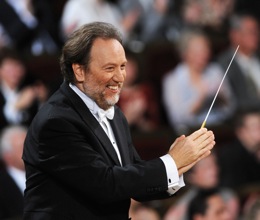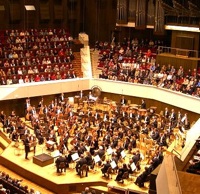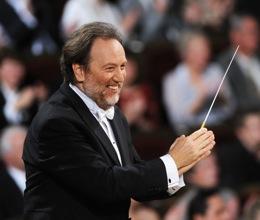
What prevailed above all was a unity of purpose, the sense of an orchestra as a single instrument devoted to whatever cause was at hand. Entrances and cutoffs were faultlessly precise. Balance and dynamics were exquisitely controlled. Every pizzicato stroke was clean. Each lyrical phrase was carefully shaped and sung. The brasses rose to their tasks in an organic way, emphatic without any piercing pyrotechnics. The woodwinds warbled and keened. The timpanist thundered and muttered appropriately.
None of this had the automatic-pilot feel that great orchestras sometimes produce. From the first storm-gathering measures of the Dvořák to the sun-burst transformations of the concluding Allegro, Chailly gave this deeply familiar work a fresh tautness, internal clarity, and drive.
Yes, the Gewandhaus opened up the dreamy, Longfellow-inspired vistas where Dvořák intended them. And yes, the musicians voiced the fleeting quotation from Beethoven’s Ninth Symphony (in Dvořák’s Ninth) at the stop of the Scherzo with propulsive force. Yet the real achievement came in the way this busily allusive work held together. Colorful as this reading was, Chailly emphasized the inner logic of the piece, Dvořák’s repeated recollections and reworkings of earlier themes. A sense of wonder took over — a marveling not only at the musical material that the composer found on his 1892 journey to America but also at the spaciousness and cosmic order that a great symphony can elicit.
In the magnificently somber Largo, to choose one movement as an example, every detail was deployed for the overall effect. The initial reticence of the woodwinds set off the achingly beautiful English-horn melody later on. The poised, breath-held character of the strings lent an air of urgent, whispered confidences. After a brighter glimmering near the end, a wistful echo of the first movement placed the Largo firmly in the symphony’s long arc.
Mind-Reading the Soloist
Marvelous as the Dvořák was, the Chopin piano concerto was every bit its equal, on quite different terms. Here, in a scrupulous partnership of soloist and ensemble, Chailly and his band seemed to anticipate each interpretive nuance, inflection, and altered tempo in Lortie’s gorgeously intimate performance. No matter how softly or quickly he played (the Rondo done in an exhilarating sprint), Lortie was supported and enhanced throughout. Every note, every inner melody and quizzical slant he introduced was perfectly audible. No grandstanding was evident, no test of wills — nothing but sweet, bracing accord.
The Gewandhaus strings, with the violins arrayed across the front and cellos and violas seated in the center, can’t be praised enough, for the warmth and richness they brought to even the most delicate pianissimos and for their responsiveness to Lortie’s insouciant dry wit. None of this is accidental, of course. Chailly, a plus-size cherub when he’s taking his bows, is explicitly demonstrative on the podium, pointing and grabbing to get exactly what he’s after.
The pianist tossed in Chopin’s Étude No. 3 in E Major as an encore. Lortie’s tender-to-turbulent spin was well-done, though it paled somewhat after the richness of what had come before. After the Dvořák, the orchestra played an encore of its own: Beethoven’s “Egmont” Overture. It was a fearsome, stops-out performance that served as a kind of arresting teaser for last night’s all-Beethoven program at Davies. Here’s hoping the Gewandhaus is planning a return visit.

